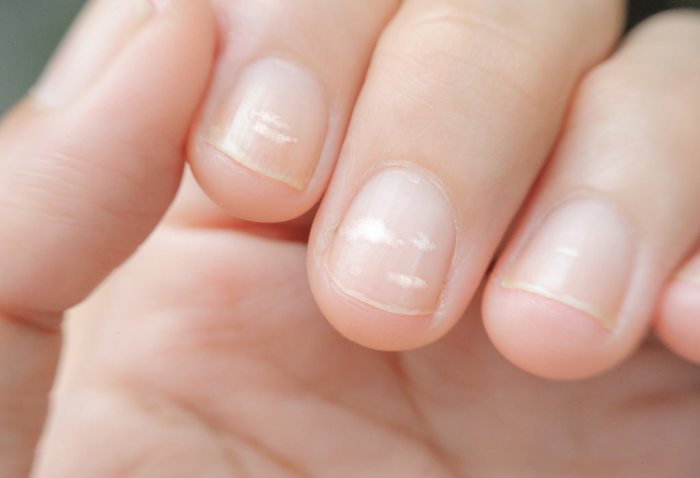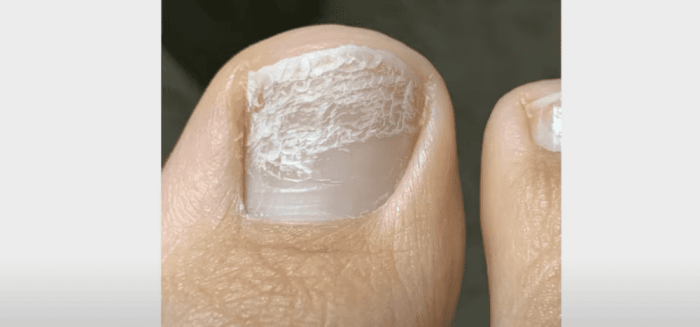White Spots Nails After Removing Polish Causes & Solutions
White Spots on Nails After Polish Removal: Understanding the Causes and Treatments: White Spots Nails After Removing Polish
White spots nails after removing polish – Removing nail polish, especially with harsh removers, can sometimes leave behind unsightly white spots on your nails. These spots can be temporary or persistent, indicating various underlying causes ranging from minor trauma to potential health concerns. This article explores the common causes, appropriate treatments, and when professional help is necessary.
Understanding White Spots on Nails After Polish Removal
White spots on nails, medically known as leukonychia, can appear after polish removal due to several factors. The key is differentiating between temporary and persistent spots to determine the appropriate course of action.
Temporary white spots often result from minor trauma to the nail matrix (the area under the cuticle where nail growth originates) or from the aggressive use of nail polish removers. These spots typically fade as the nail grows out. Persistent white spots, however, may signal a more serious underlying issue, such as a nutritional deficiency or a health condition.
Several nail conditions can manifest as white spots. These include minor trauma, fungal infections (though these often present with other symptoms), and even certain autoimmune disorders. Correct identification is crucial for effective treatment.
| Feature | Temporary White Spots | Persistent White Spots |
|---|---|---|
| Appearance | Small, scattered white spots; often fade within weeks | Larger, more defined spots; may persist for months or longer |
| Cause | Minor nail trauma, harsh polish removers, dehydration | Nutritional deficiencies (zinc, calcium), fungal infections, underlying medical conditions (e.g., kidney disease, psoriasis) |
| Treatment | Gentle nail care, hydration, avoiding harsh removers | Addressing underlying cause (e.g., dietary changes, antifungal medication, medical treatment) |
The Role of Nail Polish and Removal Products

Source: cdnparenting.com
The chemicals in nail polish and, more significantly, in nail polish removers can significantly impact nail health. Harsh removers, especially those containing acetone, can dry out the nails, making them brittle and prone to damage, including the development of white spots. Acetone-free removers are generally gentler, but even these can cause dryness with excessive use.
Gentle nail polish removal is crucial for minimizing the risk of white spots. This involves using a gentle remover, soaking nails rather than aggressively scrubbing, and moisturizing afterward.
- Always use a gentle, acetone-free nail polish remover.
- Soak cotton pads in remover and gently press them onto nails for a few minutes before wiping.
- Avoid harsh scrubbing or scraping.
- Moisturize nails and cuticles after removing polish.
- Allow nails to “breathe” without polish periodically.
Underlying Health Conditions
White spots on nails can sometimes indicate underlying health conditions. Nutritional deficiencies, particularly in zinc and calcium, are frequently linked to leukonychia. These deficiencies weaken the nail matrix, leading to discoloration. Other health issues, such as kidney disease, heart disease, and even certain autoimmune disorders, can also manifest as white spots on the nails, often accompanied by other symptoms.
- Nutritional Deficiencies: Zinc and calcium deficiencies are common causes, often accompanied by fatigue, hair loss, and weakened immunity.
- Kidney Disease: Can cause white spots alongside swelling, fatigue, and changes in urination.
- Heart Disease: May present with white spots, chest pain, shortness of breath, and fatigue.
- Autoimmune Disorders: Certain autoimmune conditions can lead to nail changes, including white spots, alongside other systemic symptoms.
Nail Trauma and Injury
Minor injuries to the nail matrix, even seemingly insignificant ones, can cause white spots to appear. The nail grows from the matrix, and any trauma at this point can disrupt the growth process, resulting in white spots on the nail plate. These spots are typically small, irregular in shape, and often scattered across the nail. The spots will grow out with the nail over time.
A nail with trauma-induced white spots might show several small, irregularly shaped white dots scattered across the nail bed, particularly near the base where the new nail growth originates. These spots may be slightly raised or flat and don’t usually affect the overall nail texture or thickness significantly. The color is typically a milky white, not distinctly yellow or brown as might be seen in fungal infections.
Home Remedies and Prevention
Several home remedies can improve nail health and reduce the appearance of white spots. These include dietary changes, the use of nail strengtheners, and regular cuticle oil application.
A balanced diet rich in protein, vitamins, and minerals is essential for strong nails. Regular application of cuticle oil keeps the cuticles hydrated and prevents dryness, while nail strengtheners can add durability and reduce brittleness.
Applying cuticle oil involves gently massaging a small amount around the cuticle area and the base of the nail. Nail strengtheners are applied like regular nail polish, allowing for a thin coat to dry completely before applying another.
When to Seek Professional Help, White spots nails after removing polish

Source: paolaponcenails.com
While many cases of white spots on nails resolve on their own or with simple home remedies, some situations warrant a visit to a dermatologist or doctor. Persistent or worsening white spots, particularly those accompanied by other symptoms, require professional evaluation to rule out underlying medical conditions.
Severe nail conditions, such as those involving significant discoloration, thickening, or pain, need immediate medical attention. A dermatologist can accurately diagnose the cause and recommend appropriate treatment.
Common Queries
How long does it take for white spots to grow out?
Sometimes, after removing nail polish, you might notice small white spots on your nails. These are often harmless, but understanding the composition of the polish itself can help contextualize this. To better grasp the potential interaction between your nails and the polish, consider learning more about what constitutes nail polish by checking out this informative resource: what is nail polish.
Understanding nail polish ingredients can shed light on why these white spots might appear, although often they simply resolve on their own.
The time it takes for white spots to grow out depends on the rate of nail growth, which varies from person to person. Generally, it can take several months for the affected area to completely grow out.
Can nail strengtheners prevent white spots?
While nail strengtheners may not directly prevent white spots caused by underlying health issues or trauma, they can improve overall nail health and reduce brittleness, potentially making nails less susceptible to damage that might lead to white spots.
Are white spots contagious?
White spots on nails are not contagious. They are caused by factors affecting the individual nail and are not transmitted from person to person.
What are some signs of a serious nail condition requiring medical attention?
Signs of a serious nail condition include persistent or worsening white spots accompanied by pain, swelling, discoloration beyond white spots, thickening or thinning of the nail, or changes in nail shape or texture. If you experience these symptoms, consult a dermatologist or doctor.
















